Titian, Venus of Urbino, 1538, oil on canvas, 119.20 x 165.50 cm (Galleria degli Uffizi, Florence); speakers: Dr. Beth Harris and Dr. Steven Zucker
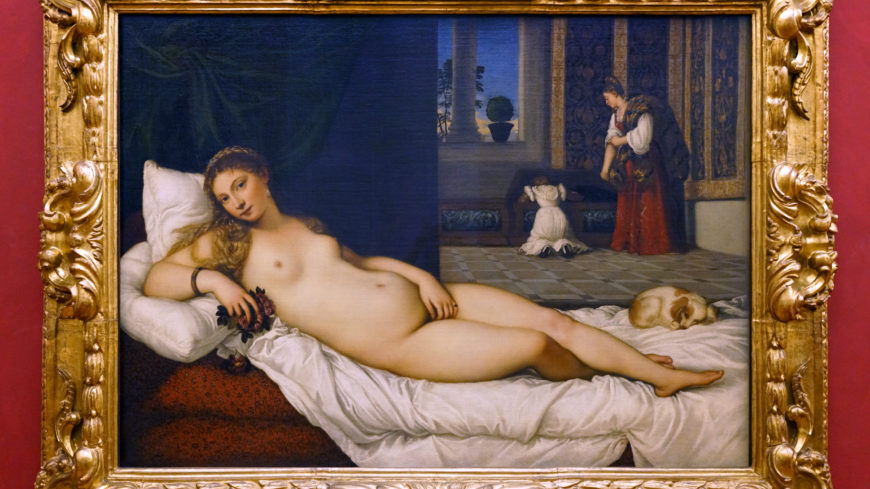
Titian, Venus of Urbino, 1538, oil on canvas, 119.20 x 165.50 cm (Galleria degli Uffizi, Florence; photo: Steven Zucker, CC BY-NC-SA 2.0)
A highly naturalistic, visual seduction
Who is she? Art historians cannot agree. Numerous identities are proposed for this nude woman seductively reclining in bed as she stares outward from an elegant bedroom. Interpretations of the figure in Titian’s oil painting on canvas, now referred to as the Venus of Urbino, range from the divine to the vulgar. She might be the goddess Venus, a young bride, or an idealized female beauty. Others see her as a courtesan or mistress. Still, she might be intended simply as a generic image of a sexy nude woman. In reality, Titian’s picture likely blends many of these rather limited identities available for women at the time, which tend to overlap within the visual culture of sixteenth-century Italy.
From the 1530s onward, Titian worked for increasingly prestigious clients that included popes, kings, the Emperor Charles V, and rulers of northern Italian court cities. Many of the hallmarks distinguishing Titian as the preeminent painter active in sixteenth-century Italy are evident in the Venus of Urbino. His expressive brushwork, dynamic composition, and brilliant coloring produce an image of pronounced sensuality. The effect is a highly naturalistic, visual seduction—in theme and technical execution—that endures as an influential prototype for depictions of the female nude in European art. Additionally, the Venus of Urbino affords rich insight into the complex social practices intertwining marriage, sexuality, and female beauty in Renaissance Italy.
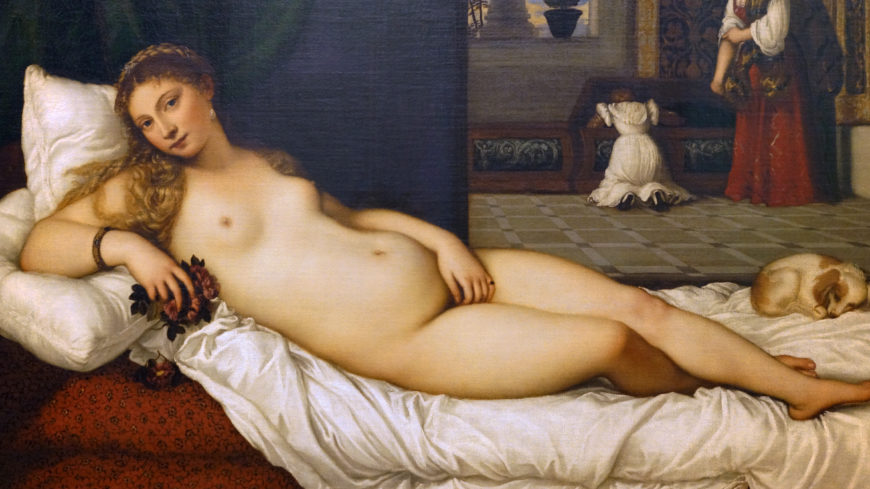
Titian, detail of Venus of Urbino, 1538, oil on canvas, 119.20 x 165.50 cm (Galleria degli Uffizi, Florence; photo: Steven Zucker, CC BY-NC-SA 2.0)
Painterly seduction
An innuendo of sexual arousal pervades the picture, which Titian emphasizes through several formal devices. The woman’s curvaceous physique is set against a matrix of rectilinear forms: bed, wall partition, window, column, chest, wall hangings, and gridded pavement. Their rigid lines contrast with her body, rendered in fluid brushstrokes that blur at the edges. Titian’s virtuosity with the technique of oil on canvas is evident in her flesh, modeled through subtle gradations in tone and color overlaid with translucent glazes. This simulates ivory skin of exceptional suppleness that flushes pink at her cheeks, hands, knees, and feet.
Set against pearly sheets, her bed cushions are rendered in crimson as if also signaling her passion and inflamed desire, presumably from the entrance of her lover for whom the viewer acts as surrogate. Sadly, much of the original impasto is lost, which once enhanced the tactile qualities of fabric and flesh. The brightly-lit figure and bed project into the foreground and tilt toward the picture plane in slightly foreshortened perspective, enhancing the sense of invitation to viewers.
Intimate viewing
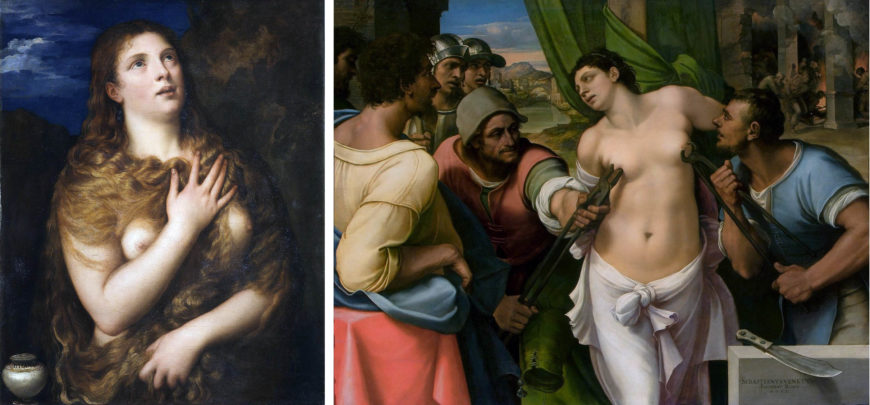
Left: Titian, The Penitent Magdalene, c. 1531–35, oil on canvas, 85.8 x 69.5 cm (Palazzo Pitti, Florence); right: Sebastiano del Piombo, Martyrdom of St. Agatha, 1520, oil on wood, 132 x 178 cm (Galleria degli Uffizi, Florence)
No indication of the subject, meaning, or use of Titian’s Venus of Urbino is given when it is first mentioned in a 1538 letter written by its patron, Guidobaldo II della Rovere, duke of Urbino. He merely refers to it as “the nude woman” (“la donna nuda”). Its present title stems from Titian’s early biographer, Giorgio Vasari, who describes the picture in the duke’s guardaroba (wardrobe suite) at his palace in Pesaro as: “a young recumbent Venus with flowers and certain fine draperies about her, very beautiful and well finished.”[1]
The installation of the Venus of Urbino in the ducal guardaroba meant it was intended for private viewing. It hung alongside other highly sexualized paintings showcasing nude female bodies arranged in classicizing poses: Titian’s Penitent Magdalene and Sebastiano del Piombo’s large Martyrdom of St. Agatha. The prominent green curtain flung back in the Venus of Urbino mimics the custom of keeping portraits with explicit or illicit content—such as courtesans—covered with silk cloths. Titian evidently used the same model appearing in the Venus for several other portraits for the dukes of Urbino, suggesting she might be Guidobaldo’s mistress.
Rather than a specific person, however, Titian’s Venus more likely represents a generic and idealized female beauty. She corresponds to the image type known as belle donne (beautiful women) he helped popularize in Venice. Women appear in such pictures, sometimes in the guise of ancient heroines, according to a standard formula: fair skin; loose blonde hair; flirtatious glance; provocative clothing or nude; a floral offering; and expensive jewelry. Contemporary love poetry provided the inspiration for these canons of beauty, grounded in lustful male fantasy, celebrating the beloved’s duality as a chaste yet erotic companion.
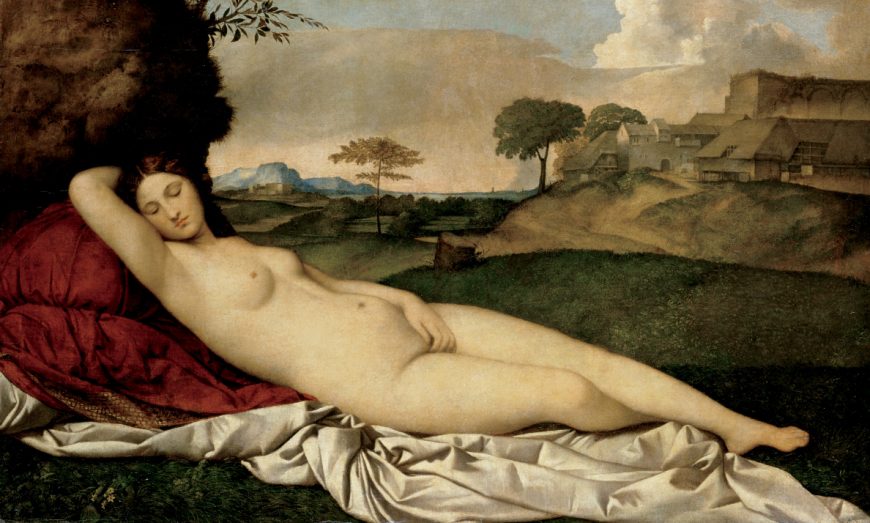
Giorgione, Sleeping Venus, c. 1508–1510, oil on canvas, 108.5 x 175 cm (Staatsliche Kunstsammlungen, Gemäldegalerie Alte Meister, Dresden)
Venus and Renaissance marriage
Titian based his composition for the Venus of Urbino on his colleague Giorgione’s Sleeping Venus, featuring a naked woman reclining as if asleep in a sunny meadow. The overt sensuality of the imagery relates to the special role of Venus as goddess of love, sexuality, fertility, and beauty. Because of this, she also served as the patroness of marriage. The subject of the sleeping Venus was central to epithalamia (songs or poems celebrating marriage) popular in Greek and Roman antiquity, and revived in Renaissance Italy.
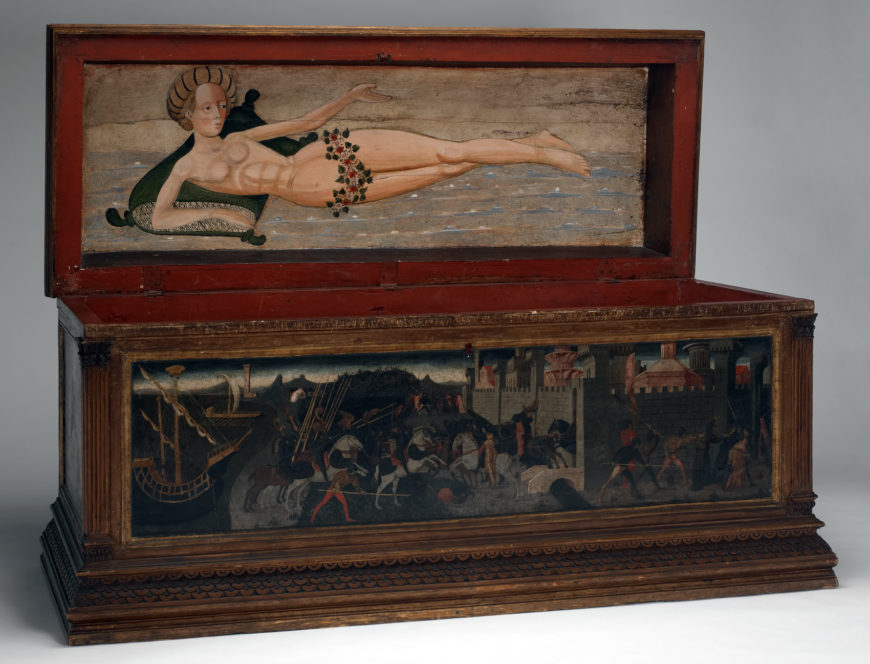
Paolo Uccello, cassone, with scenes of the Battle of Greeks and Amazons before the Walls of Troy; Allegories of Faith and Justice; and Reclining Nude, c. 1460, tempera on panel, 88.9 × 196.9 × 73.7 cm (Yale University Art Gallery, New Haven)
One of Titian’s innovations involves the liberation of the nude, once hidden inside furniture, to a subject for an independent easel painting. Given her connection to marriage, Venus became a fashionable subject for artists to paint on cassoni, the large wedding chests containing trousseau and stored in a newly-wed couple’s nuptial chamber.
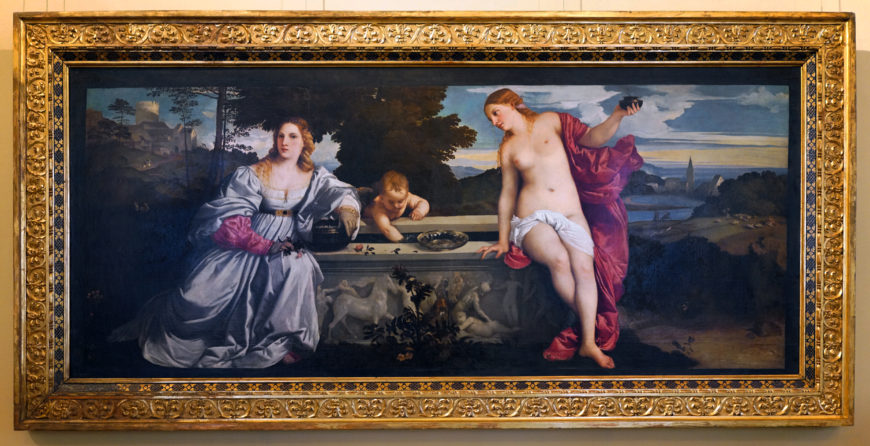
Titian, Sacred and Profane Love, 1514, oil on canvas, 118 x 279 cm (Galleria Borghese; photo: Steven Zucker, CC BY-NC-SA 2.0)
This may explain the oblong horizontal format of the Venus of Urbino, which resembles earlier fifteenth-century panels found on the underside lid of Florentine cassoni. This is the format of Titian’s earlier painting, Sacred and Profane Love, which more certainly commemorates a marriage and also depicts Venus disrobed alongside a bride.
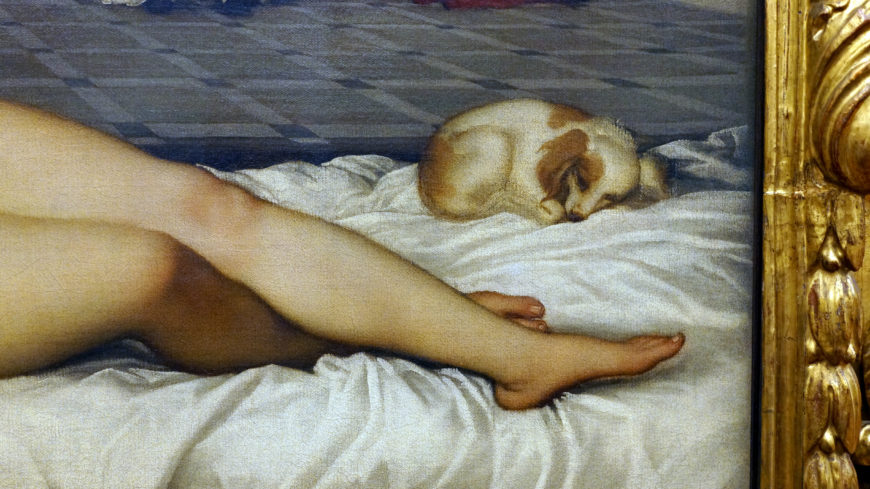
Titian, detail of the sleeping dog, Venus of Urbino, 1538, oil on canvas, 119.20 x 165.50 cm (Galleria degli Uffizi, Florence; photo: Steven Zucker, CC BY-NC-SA 2.0)
Why Titian was asked to paint the Venus of Urbino is unclear, though it possibly commemorates the 1534 wedding of duke Guidobaldo to Giulia da Varano (then merely ten years old). Numerous elements of the painting allude to marriage. The device of a sleeping dog (here a toy spaniel) often symbolizes marital fidelity. The bouquet of roses, also embroidered on the bed cushions, are associated with Venus and the constancy of love, as is the myrtle plant prominently silhouetted in the background window. Titian’s Venus may have been commissioned on the occasion of Giulia’s sexual maturity, when she and Guidobaldo could rightfully consummate their marriage occurring four years prior.
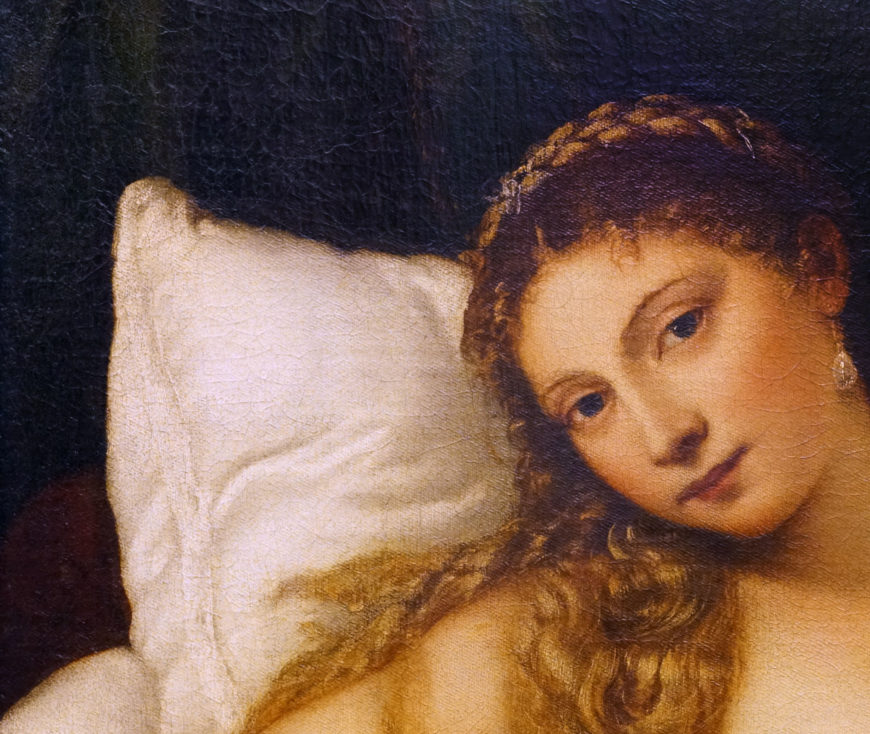
Titian, detail Venus of Urbino, 1538, oil on canvas, 119.20 x 165.50 cm (Galleria degli Uffizi, Florence; photo: Steven Zucker, CC BY-NC-SA 2.0)
Audiences would have recognized the woman’s distinctive hairstyle in the Venus of Urbino as the type for engaged young women. Brides sported blonde hair (often dyed) spread loosely over the shoulders and interlaced with golden filaments and fitted with a fancy tiara. In this case, the braids atop her head correspond to such an item and are styled to mimic it. Her expensive pearl earrings, ring, and bracelet may relate to the practice of bestowing such jewelry on brides. Attendants gather a lavish blue and gold dress from two large cassoni in the background, alluding to dowry goods but also Venetian engagement ceremonies when fancy gowns were worn.

Titian, Venus of Urbino, 1538, oil on canvas, 119.20 x 165.50 cm (Galleria degli Uffizi, Florence; photo: Steven Zucker, CC BY-NC-SA 2.0)
Focal point of the composition
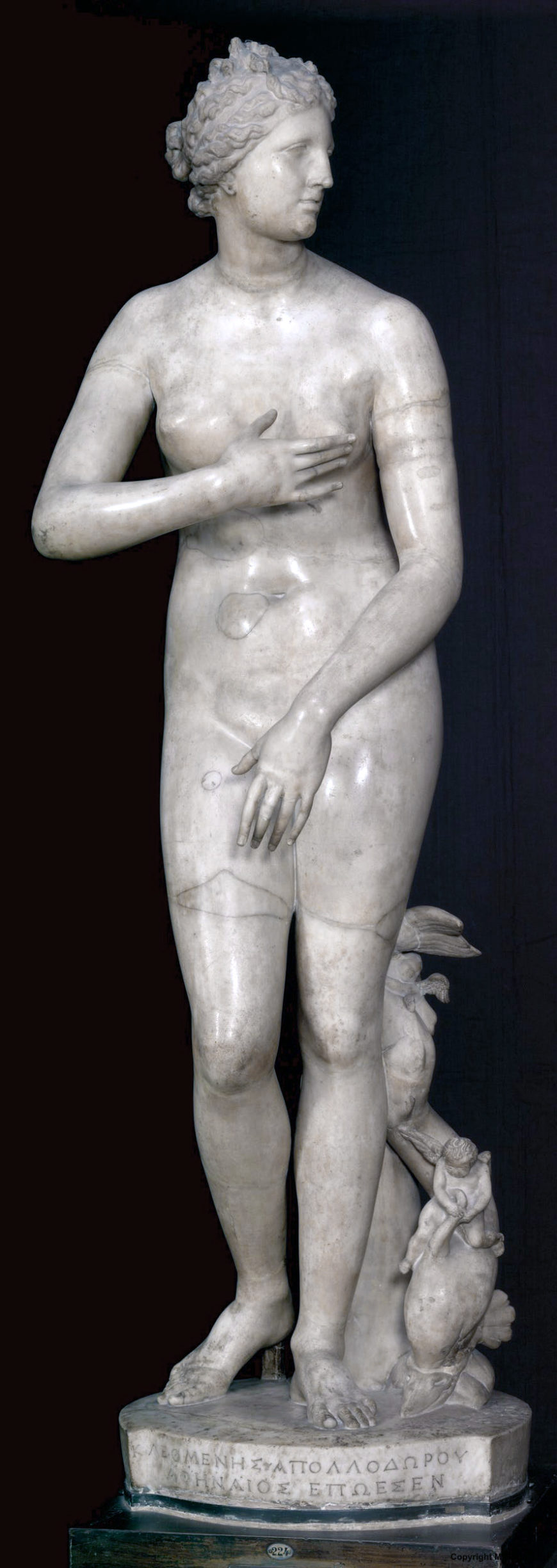
Medici Venus, late 2nd to early 1st century B.C.E. marble, 153 cm (Hellenistic copy after Praxiteles’ Aphrodite of Knidos, 4th century B.C.E.; Galleria degli Uffizi, Florence)
Titian leaves no doubt that the woman’s pelvis is the focal point of the composition. The geometry and spatial construction pull our attention directly to it. The actual lines of the middleground partition wall and rear edge of the bed intersect at her genitals, practically forming a bull’s-eye. Though some hesitate to address it, her groin, along with the action she performs there, is the visual and thematic axis upon which the narrative turns.
At one level, Venus’s covering of her genitals with her hand involves an erudite allusion to ancient Greek and Roman sculptures of the Venus pudica (“modest Venus”), known in Titian’s time through dozens of copies in various sizes and media. Like her classical model, the pose of Titian’s figure ironically emphasizes rather than conceals her sexual organs. Yet unlike the Venus pudica, Titian’s nude appears to be contracting her fingers in a caress—instead of merely hiding her genitalia from view. Titian playfully accentuates this action by balancing the twist of her left hand with the knotted draperies in the upper left corner— a visual rhyme lending a further erotic charge.
Some modern scholars see the Venus of Urbino as nothing more than a sexy pinup for elite clientele. Others reason that such a label unfairly judges the image according to modern sexual paradigms. For social historians of art, dismissing the picture as mere pornography ignores its more complex functions as a marriage picture rooted in sixteenth-century customs for Italian brides and grooms.
Art historian Rona Goffen convincingly argues that this matrimonial context explains the woman’s seductive glance and gesture of masturbation, both of which anticipate the husband in the bridal chamber and consummation of marriage. Renaissance medical theories advised married couples that simultaneous orgasm during intercourse, as well as the woman’s positioning on her right side, increased probability of conceiving children. Women were encouraged to self-stimulate if needed to achieve this outcome.
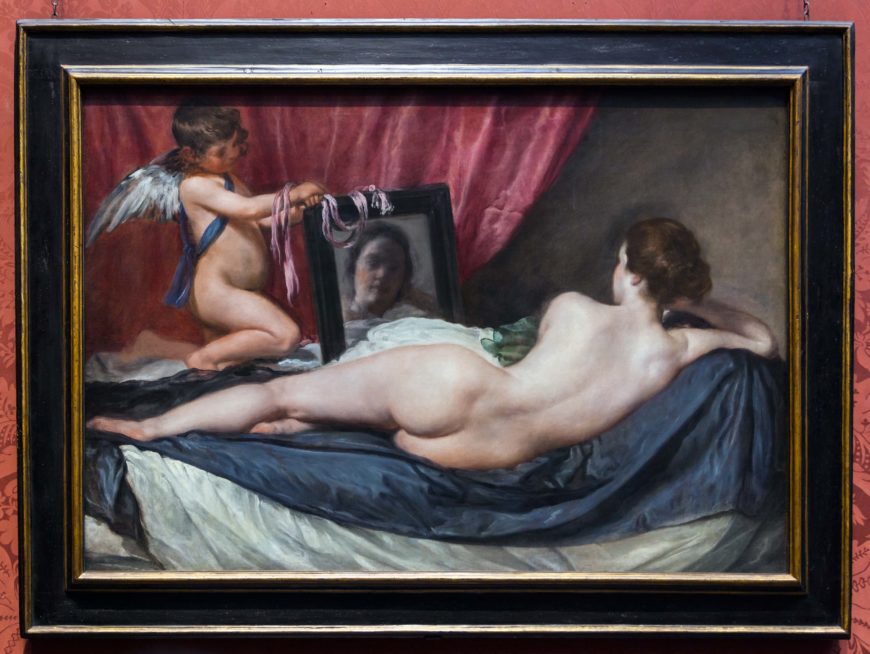
Diego Velázquez, The Toilet of Venus (also known as The Rokeby Venus), 1647–51, oil on canvas, 122.5 x 177 cm (The National Gallery, London; photo: Diego Delso, CC BY-SA)
Female nudes and the gaze
Numerous variations of the Venus of Urbino attest to its notoriety in Renaissance Europe. It has also profoundly shaped subsequent formulas for representing the nude female body in the western canon. Initially construed as a private matrimonial image, this theme evolved from the sixteenth through nineteenth centuries as a conventional academic subject-matter for artists. Its influence can be measured in works by renowned painters such as Diego Velázquez, Peter Paul Rubens, Rembrandt, Francisco de Goya, and Jacques-Louis David.
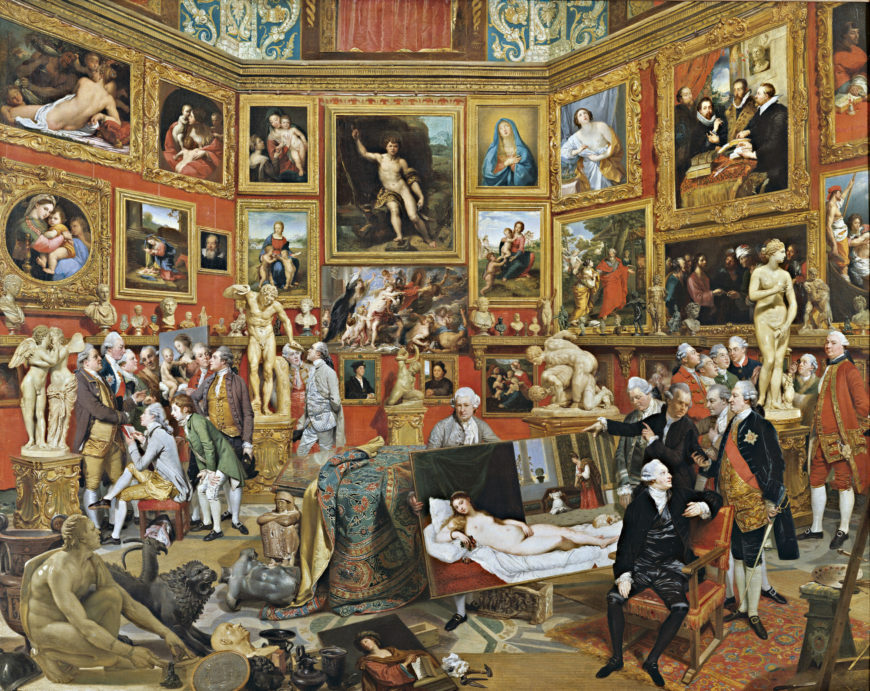
Johan Joseph Zoffany, The Tribuna of the Uffizi, 1772–1777, oil on canvas, 123.5 x 155 cm (Royal Collections, Windsor Castle, Windsor, Royal Collection Trust / © Her Majesty Queen Elizabeth II 2020)
The visual traditions of the female nude have been challenged by feminist interventions in the history of art. Art historians increasingly see works such as the Venus of Urbino as symptomatic of sexist social structures that reduce women—real or painted—to passive sex objects displayed for visual consumption. This phenomenon, now referred to as the male gaze, is problematic since it recognizes that women are represented in visual culture from an assumed male heterosexual viewpoint.
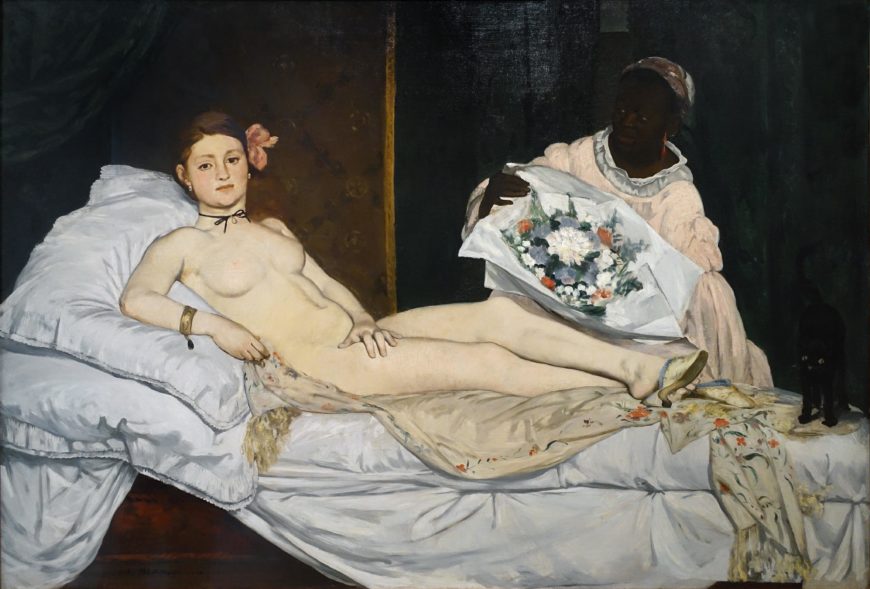
Édouard Manet, Olympia, 1863, oil on canvas, 130 x 190 cm (Musée d’Orsay, Paris; photo: Steven Zucker, CC BY-NC-SA 2.0)
By the eighteenth century, the erotic spectacle of the Venus of Urbino for male audiences is clear. It forms the centerpiece of Johan Zoffany’s depiction of the Uffizi galleries, where over twenty men have gathered to scrutinize esteemed artworks throughout the history of art—their gratification seemingly sexual as well as aesthetic. Perhaps most notorious is Édouard Manet’s reinterpretation of the Venus of Urbino in his painting of Olympia, which replaces Venus with a prostitute. This choice shocked the nineteenth-century French public and has since, somewhat unjustly, distorted readings of Titian’s picture as a similarly vulgar episode of illicit seduction.
Notes:
[1] Quoted in Rona Goffen, “Sex, Space, and Social History in Titian’s Venus of Urbino,” in Titian’s Venus of Urbino, ed. Rona Goffen (Cambridge: Cambridge University Press, 1997), pp. 72–73
Additional resources:
Read about gender in renaissance Italy
This work at the Gallerie degli Uffizi in Florence
Discover Titian’s Venus of Urbino on Google Arts & Culture
The art of lying: reclining figures through history from Art UK
More about Titian from The National Gallery
Andrea Bayer, ed., Art and Love in Renaissance Italy (New York: Metropolitan Museum of Art, 2008)
Omar Calabrese, ed., Venere Svelata: La Venere di Urbino di Tiziano (Milan: Silvana, 2003)
Rona Goffen, Titian’s Venus of Urbino (Cambridge: Cambridge University Press, 1997)
Smarthistory images for teaching and learning:
[flickr_tags user_id=”82032880@N00″ tags=”TitianUrbino,”]

